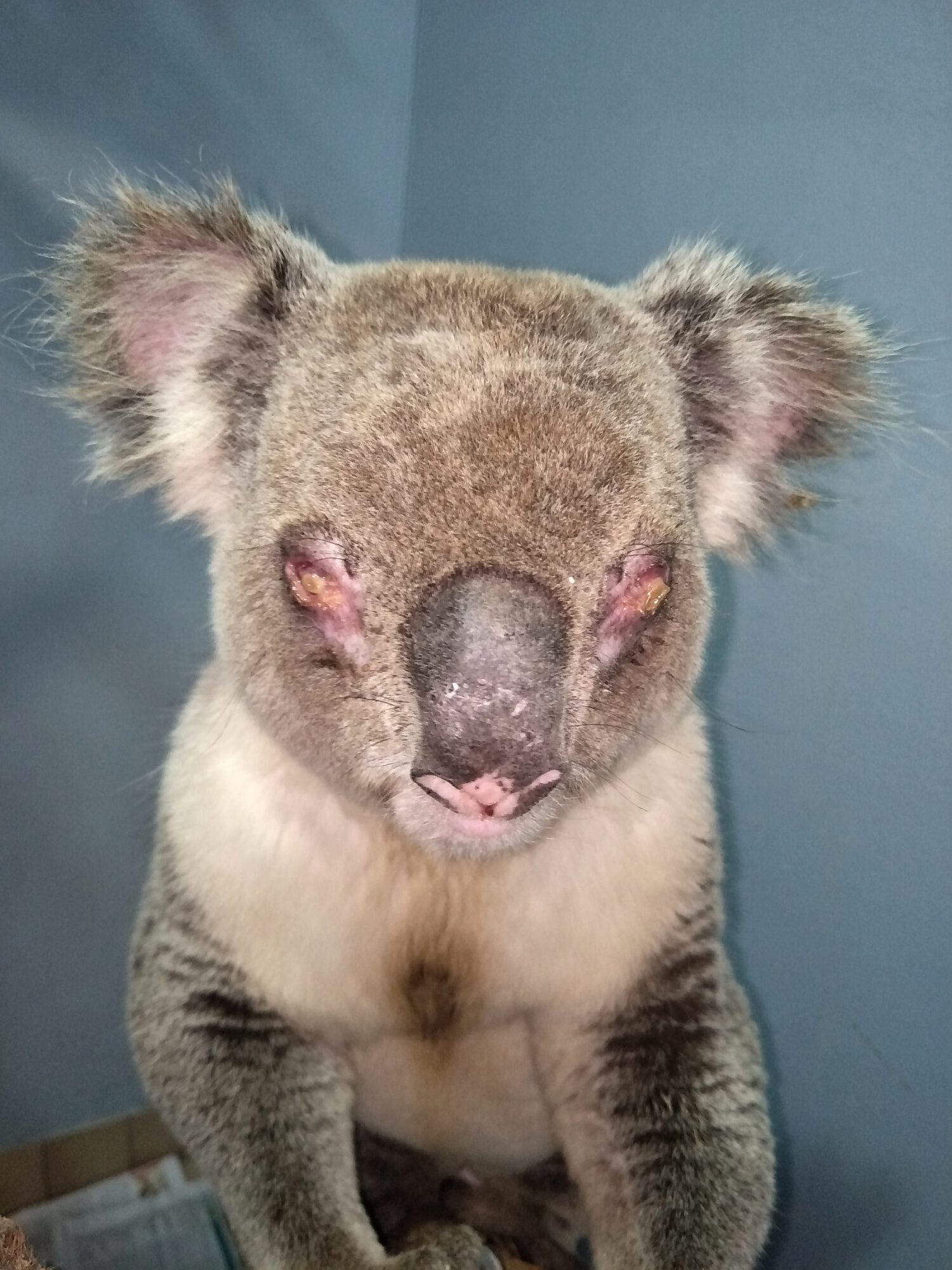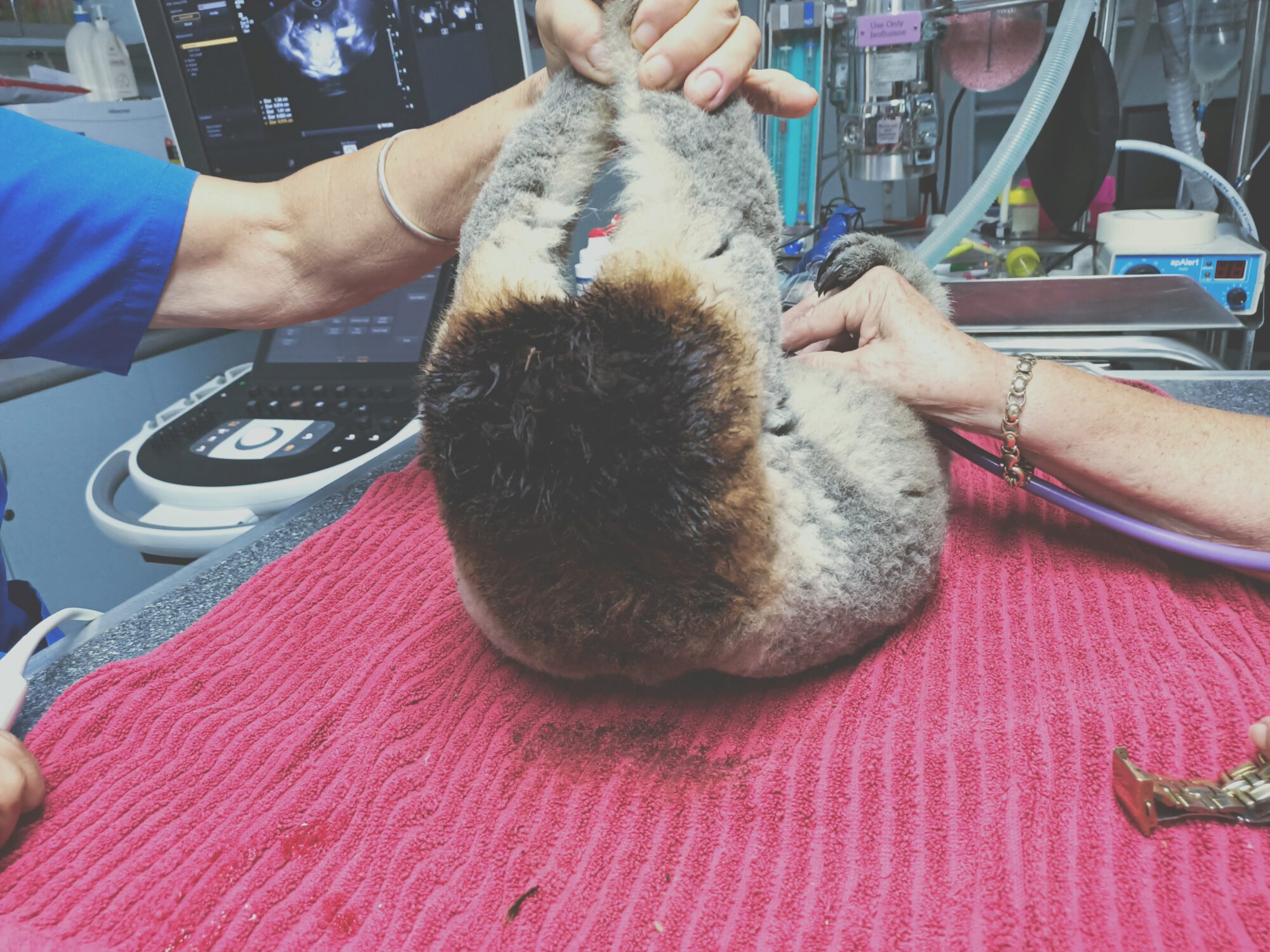Chlamydia
Koalas in this country are now in serious decline with the key threatening process to their survival being land clearing and thus loss of koala habitat. This is not unique to koalas as all species of wildlife worldwide who are in decline are suffering the same plight as a result of removal of forests, climate change, pollution of oceans, and waterways. For koalas this loss of vegetation not only removes the trees that sustain them, but increases the chances of being hit by cars, attacked by dogs and suffering from diseases such as Chlamydiosis.
What is Chlamydia?
Chlamydia is an obligate, intracellular bacteria that is found in many species of bird and mammals worldwide.
For example, Chlamydia psittaci a species of chlamydia infecting birds particularly parrots, is also considered a zoonotic disease which can be transmitted to humans causing severe illness.
In humans, Chlamydia trachomatis also found worldwide, is considered a sexually transmitted disease affecting both the urogenital tract and the conjunctiva (eyes). Alarmingly, this disease is on the rise in developed countries in spite of good public education.
*Even koalas are not spared from this bacterium Chlamydia. Koalas suffer from two species of Chlamydia – Chlamydia pneumoniae and Chlamydia pecorum.*
For simplification it is suffice to say that within these two species are many strains and as research continues more are being discovered.
So how does chlamydia occur in koalas?
It is likely that many strains of this disease have existed for a very long time within koala population, acting as natural population regulators. In the early 1800’s Europeans settling in Australia brought with them agricultural livestock such as sheep, cattle and pigs. Records from this period reported koalas “curled up at the base of trees, with diseased eyes and looking very sick”. Research using DNA sequencing has shown that some of the current strains of chlamydia are very similar to those found in cattle, sheep and pigs. It is highly likely that these strains of chlamydia “jumped ship” from agricultural animals into koalas – how this transmission occurred is still largely unknown. These “newer” strains are considered to be more virulent exposing koalas to diseases they have not had enough evolutionary time to adapt to and thus the disease had a major impact on wild koala populations even as far back as the 1800’s. This scenario is similar to our first nation’s people of this country who were first exposed to European diseases in the 1880’s such as influenza with disastrous results.
Chlamydia can exhibit as ocular disease (infecting the eyes) or the urogenital form (infecting the reproductive tract and the urinary tract) or koalas can exhibit both at the same time.
Some koalas can appear quite healthy with no clinical signs of the disease but can still carry the pathogen (sub-clinical) and may never become unwell during their lifetime.
Interestingly, a much higher expression of this disease occurs in areas of disturbed habitats such as peri urban (beside) and urban environments, agricultural and mining areas with reduced vegetation, in areas of high bushfire impact and now in areas suffering from hotter, drier conditions. This higher expression of disease in these areas makes sense as koalas are either forced closer together to compete for resources or further apart and struggle to find food and shelter. Genetic inbreeding occurs in areas of fragmented habitat as does koalas forced to seek refuge in areas of poor soil and moisture quality. In good healthy forested areas that are undisturbed, the incidence of chlamydial disease is very low.
When koalas are first admitted into the hospital, they undergo a full health screen examination. This is done under anaesthesia with the koala given a full physical assessment, blood tests are done and a PCR swab (Polymerase chain reaction which detects chlamydia cells) and finally an ultrasound to check the urogenital tract and other internal organs that may be affected by this disease. If the koala does not have disease that is too far advanced to be treated, then the koala will commence a 4-6 week treatment plan. At the end of the treatment plan, the koala is held for a further two weeks and “left alone”, then the koala is given a full health screen under anaesthesia again and if everything has been deemed “successful”, the koala is eartagged, microchipped and released back to its capture point.

Bilateral conjunctivitis
So what do we look for?
In the ocular (eye) form of this disease the conjunctiva of the eye is normally the first point of noticeable infection. It becomes red and inflamed, the tissue begins to swell and a purulent (pus filled) discharge can often commence. As the disease progresses, it can invade the cornea (the front of the eye itself) and/or the conjunctival tissue creates an inflammatory response where the tissue becomes so swollen and prolific it completely covers the eye and the koala is unable to see. In advanced stages the koala is rendered blind and they usually starve to death as they are unable to locate trees. In the early 1980’s the Koala Hospital pioneered an excellent procedure where the damaged conjunctival tissue was surgically removed and even today this procedure is still considered an important part of the treatment plan and has been adopted throughout Australian veterinary clinics.
If the koala is admitted to care in the early stages of ocular infection, there is usually an excellent chance of successful treatment.
Urinary and reproductive tract infection is a much more complex scenario. Whilst the disease chlamydia does not favour either sex and will happily infect both male and female koalas alike, the female koala has “more plumbing” to deal with and therefore more complications can arise. There are many cases where koalas have become infected whilst in the wild and have recovered unassisted, with some not becoming unwell again into the future. Other koalas may also recover from a new infection, but it usually leaves some sort of residual structural damage to the bladder wall, the reproductive tract and even the kidneys. In future seasons the koala can become infected again either with a new strain of the pathogen or their immune system becomes compromised and the original disease “flares up” again. Every time a koala becomes sick, more structural damage is done internally, no matter how well they may appear. Some koalas become infected for the first time and become so diseased, they deteriorate and die in a matter of weeks. Much of how koalas respond to this disease is driven by genetics, soil quality and soil moisture/nutritional status of trees, multiple pressures from disturbance of habitats, climatic conditions and how virulent the actual strain of the disease is in the area they live.
Bear in mind here, koalas can have both the ocular and the urogenital tract disease at the same time as well.
The koala suffering from urogenital chlamydia will undergo a full health assessment under anaesthesia soon after being admitted to care.
If during this assessment the internal structural damage is so advanced, that the future quality of life for the koala is very poor then the kindest thing to do from an animal welfare perspective is to euthanase the koala whilst it is under anaesthesia. At the Koala Hospital (and across the country) relieving animals of severe pain is a major component of what we do.
So what is “internal structural damage”?
The healthy bladder wall of a koala is no different from any other species in having a thickness equivalent roughly to a rubbery thin balloon. This beautifully designed set of muscles is used to both hold and expel urine. In an infected koala the wall of the bladder can become so thickened and fibrotic that it becomes ineffective in both holding and expelling urine – the koala becomes incontinent and continually drips urine hence the term “wet bottom” or “dirty tail” to describe a sick koala. The internal wall of the bladder can also become so inflamed and swollen, the koala continually passes blood and purulent material. This sort of damage is simply not treatable with drugs and is both incredibly painful for the koala and distressing for the human carer to witness.

The disease can ascend into the kidneys causing renal disease and failure. Again, very painful and simply does not allow the koala to function as they should.
From a reproductive tract point of view, the male’s prostate can become inflamed, swollen, painful and obstructive to the flow of urine.
The female’s reproductive tract can become swollen and inflamed with females developing what are termed “paraovarian cysts”, which are cysts that are found beside the ovaries in the bursal sac that surrounds the ovarian tissue. These cysts can become enormous and have the capacity to occupy a large area of the abdominal cavity pushing and adhering to other organs. The fluids encased in these cysts can be filled with all sorts of nasty inflammatory material which not only can rupture, but they render the female totally infertile for future breeding. Female koalas can also suffer from pyometra (purulent material in the uteri).
As with the ocular form of the disease early intervention is the only thing that offers any sort of good outcome. More often than not koalas are not admitted until they have become seriously unwell as they behaviour dictates that koalas remain high in the trees until they feel so sick they come down low enough to be spotted by home owners who then report the sick koala.
Sometimes koalas can be admitted for independent reasons such as being hit by cars and as an incidental finding, a chlamydial infection is found as well (or was the koala on the road because it was sick?).
How do we treat this disease?
As a specialist folivore, koalas have evolved to cope with the toxic compounds found in eucalypt leaf by a number of mechanisms. Koalas have what is dubbed a “super liver” which is designed to breakdown and metabolise these toxins and eliminate them from the body. The koala also has a large gut system plus a two metre caecum filled with a suite of micro-organisms (microbiome) all designed to breakdown the leaf allowing uptake of nutrients.
There are a number of antibiotics that are capable of killing the chlamydia in koalas but have the potential to kill off the important microbiome and as a result can kill the koala. Treating koalas for this disease is difficult as there is a fine line between successful treatment and causing harm to the koala.
Other medications such as non steroidal anti inflammatory drugs are metabolised and eliminated by the “super liver” before they are able to do the job they are designed to do.
It is worth noting here that both the NSW and Qld koala populations are struggling to survive far more than the Victorian and South Australian populations.
In some Victorian locations, the koala populations have “bred well and have eaten themselves” out of habitat, stripping the trees bare. Management of these starving populations has been highly controversial and will not be part if this story, but suffice to say that translocaton of these populations, along with sterilisation of females and euthanasia of koalas has formed part of the management strategy. There have been suggestions that these koalas should be translocated to NSW and Qld where our koalas are rapidly disappearing.
Whilst this may appear to be a sensible suggestion sadly it is not. Both Victorian and South Australian koalas are much bigger than their counterparts in NSW and Qld and have much thicker fur. This is an example of clinal distribution where animals and plants have evolved and adapted to suit different climatic conditions. Both NSW and Qld koalas are much smaller, with finer fur and are adapted to survive in hotter climates. From this standpoint alone Victorian and South Australian koalas would not cope with our northern climate. Even though Victorian and South Australian koalas do get infected by chlamydia, it is generally felt that the strains “down south” are far less virulent than the strains in NSW and Qld. Therefore the southern koalas would more than likely be wiped out by the NSW and Qld chlamydial pathogens if they were translocated into NSW and Qld. This is without even going into the whole genetics debate!
What is the answer to this whole dilemma to reverse the decline of koalas?
There needs to be far better management strategies and tighter more robust legislation put in place by both the Federal and State governments to ensure their protection well into the future. There needs to be large amounts of quality undisturbed forested environments free of humans set aside where koalas can live undisturbed to breed and remain healthy.










